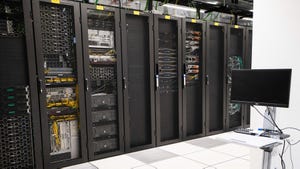
Insight and analysis on the data center space from industry thought leaders.
Navigating Scope 3 Emissions for Sustainable Data Center OperationsNavigating Scope 3 Emissions for Sustainable Data Center Operations
Data center operators must adopt a data-driven approach to assess and manage their Scope 3 emissions, writes Carsten Baumann, director at Schneider Electric.
July 11, 2024

Every day, an increasing number of data center operators are exploring the transition to clean energy for their power needs. With mounting pressure to mitigate climate change, there is also a global focus on reducing Scope 3 emissions.
Scope 3 emissions include all indirect emissions from sources such as a data center’s supply chain and customer base, waste management, and business travel. These indirect emissions are the primary contributor to greenhouse gas (GHG) emissions for data centers in the coming years.
Concerningly, despite their significance, Scope 3 emissions are the least reported and understood. Although achieving carbon neutrality and net-zero status is a critical step forward, the challenge lies in adopting a standardized approach and comprehending the necessary metrics for measuring and reporting these emissions, which can be overwhelming.
The focus on quantifying Scope 3 emissions within the value chain is part of a broader effort by organizations to comprehensively assess and manage their environmental impact. However, it requires a data-driven approach to help data center operators identify and categorize emissions from construction to operations and the supply chain, then prioritize efforts to make impactful carbon reductions.
Undertaking this process enables more informed decision-making and targeted efforts to reduce carbon emissions throughout the value chain. Developing a strategy to identify and ultimately mitigate the biggest sources of carbon emissions in the value chain is quickly becoming a priority for the data center industry, alongside the need to establish easy-to-use frameworks.
Data Collection Practices for a Reporting Framework
The effort to quantify and manage Scope 3 emissions aligns with broader trends in data center sustainability and corporate responsibility. Many organizations recognize the importance of transparently addressing their environmental impact as part of their commitment to sustainable practices. However, they often do not know where to start, what type of reporting framework to use, or how often to collect and report data.
Quantifying and reporting Scope 3 emissions presents significant challenges for data center operators, primarily due to a lack of reliable supplier data,
These emissions vary significantly depending on factors such as data center size, redundancy level, location, electricity emission factor, core and shell construction, IT equipment configuration, energy efficiency, equipment lifespan and replacement frequency, and value chain activities.
Sustainability Reporting Can Provide a Competitive Advantage
The proactive stance of data center operators towards achieving net-zero climate goals reflects a broader shift in business attitudes toward sustainability. As environmental concerns become more prominent, companies recognize the need to align their operations across the value chain with climate goals to meet the expectations of stakeholders, including customers, investors, and vendors, contributing to a more sustainable future.
Beyond compliance, GHG reporting, including Scope 3 emissions, is increasingly recognized as a strategic and beneficial practice for the data center industry. In 2022, research reported that 83% of data center operators use sustainability to attract new business, while only 72% are just beginning their sustainability journey. This trend aligns with the growing emphasis on sustainability, helps manage risks, and positions companies as responsible and forward-thinking entities in an environmentally conscious market.
Robust emissions reporting can enhance investor confidence and attract investment from those seeking sustainable and responsible opportunities. Data centers that prioritize emissions reduction and extend their sustainability efforts to their supply chains can gain a competitive edge. A resilient and sustainable supply chain can contribute to business continuity and enhance a company's overall reputation.
Vendor Commitment to Reducing Embodied Carbon
Scope 3 emissions are the most challenging to report for data center operators. They should integrate sustainability into their evaluation criteria when selecting data center equipment suppliers and service providers to minimize the Scope 3 value chain carbon footprint.
Vendors need to commit to reducing the embodied carbon of their product portfolios. Data center equipment suppliers must make environmental product disclosure documents freely available and easily understandable.
By actively seeking equipment suppliers and service providers committed to reducing their environmental impact, data center operators can play a crucial role in mitigating the overall carbon footprint associated with their operations.
Read more of the latest data center sustainability news
The call for transparency and the availability of environmental product information further enhances the ability to make sustainable choices in the selection of data center equipment.
Noticeably, procurement departments are also starting to pay attention to sourcing materials and equipment with reduced Scope 3 emissions.
Following these initial steps will allow data centers to expand their understanding of Scope 3 emissions and implement the right tools and measurement practices to work towards reducing their overall environmental impact.
Carsten Baumann is director of strategic initiatives and solution architect at Schneider Electric.
About the Author
You May Also Like









